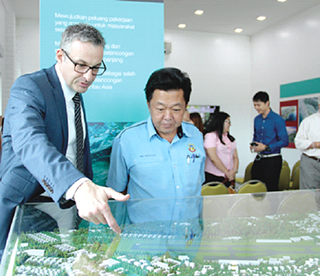Set for Tg Aru's transformation
Published on: Wednesday, June 29, 2016

Kota Kinabalu: The first phase of the billion-ringgit Tanjung Aru Eco Development (TAED) project designed to transform Sabah into a premier tourism destination in the region is scheduled to commence early next year. Among the features to expect at the waterfront development that, unlike elsewhere in Malaysia is equidistant to both the international airport and the city centre, include the experience of walking in a rainforest, a marina, cycling in dedicated lanes, facilities for beach football and volleyball, a children's playground and an amphitheatre for hosting events and performances.All these would see thousands of jobs created for Sabahans in the hospitality, tourism and retail industries.
ADVERTISEMENT
Project Director Peter Adam, from Savills Development, said the project would take up 348 hectares, with 65 per cent of it reclaimed, and that around half of TAED would be accessible to the public. The project's second phase would follow in September 2017, third phase in September 2018 and fourth in March 2019. "The project is scheduled to be completed by end of 2019," Adam said during a media briefing on the project, Tuesday.
ADVERTISEMENT
The project would be divided into eight unique character zones namely Tanjung Aru Beach, Prince Phillip Park, Prince Philip Wharf, Aru Gateway, Aru Village, Aru Oceanfront, Aru Marina and Golf Retreat, as well as the construction of a 42-metre wide canal along the project for a length of around five to six kilometres. The eco-signature golf course would be designed by pro-golfer Greg Norman.
ADVERTISEMENT
The development includes the construction of several hotels of about 1,800 rooms, 22 residential developments with more than 4,000 new dwellings, a water theme park, dedicated cycling lanes and electric bus lines, which Adam maintained would follow strictly to the green building initiatives. For the reclamation, the earthworks would be sourced at a location 55 kilometres into the sea, while flood gates would be constructed to control the level of water inside the canal to avoid sand erosion during low and high tide, as well as strong waves. "Tg Aru beach will be rejuvenated and cleaned up while Prince Philip Park will be expanded to 12 hectares or more than double its current size. "Importantly, the beach and park will continue to remain public areas with new features such as a promenade, walking and cycling tracks and an ecology centre," said Adam.According to project environmental consultant, Tania Golingi, from DH Water and Environment, the Special Environmental Impact Assessment report for TAED would be submitted to the Environment Protection Department in September. "It will be opened for public viewing the same month, where we welcome any comments and concerns from the general public over the development," she said. The announcement of the TAED two years ago drew concerns from conservationists on the environment, restrictive public access and massive reclamation of a beachfront. Such fears were allayed by Mayor Datuk Yeo Boon Hai who assured that TAED, which is to rejuvenate the charm of the beach internationally acclaimed for its picture postcard sunsets, would see to it that its development is environmentally sound. "I can personally assure that 1.3km of the beach will be maintained for the public. I also want my children and future generations to be able to enjoy it. "I also want to protect it. I will have failed in my duty as a mayor if I didn't take the people's views into consideration," said Yeoh, who believed TAED would help boost eco-tourism in the State. Yeo also admitted that he was the one who insisted that the gazetting of the Prince Philip Park be doubled from its existing size to 12 hectares."I have done a lot of homework on waterfront cities like the Gold Coast in Australia. I want to ensure that we will be able to develop Tanjung Aru in a green way, and maintain the rainforest theme. I am not forgetting our heritage," he said. Yeo also assured that barely any heritage tree would be felled throughout the span of the project, noting that an inventory of the number of trees and its species had been made ahead of the project. Meanwhile, Golingi said nesting boxes would be built as a temporary habitat for the indigenous birds in the area which include a pair of hornbills, as well as parrots, Java sparrow and others. Stay up-to-date by following Daily Express’s Telegram channel.
Daily Express Malaysia




